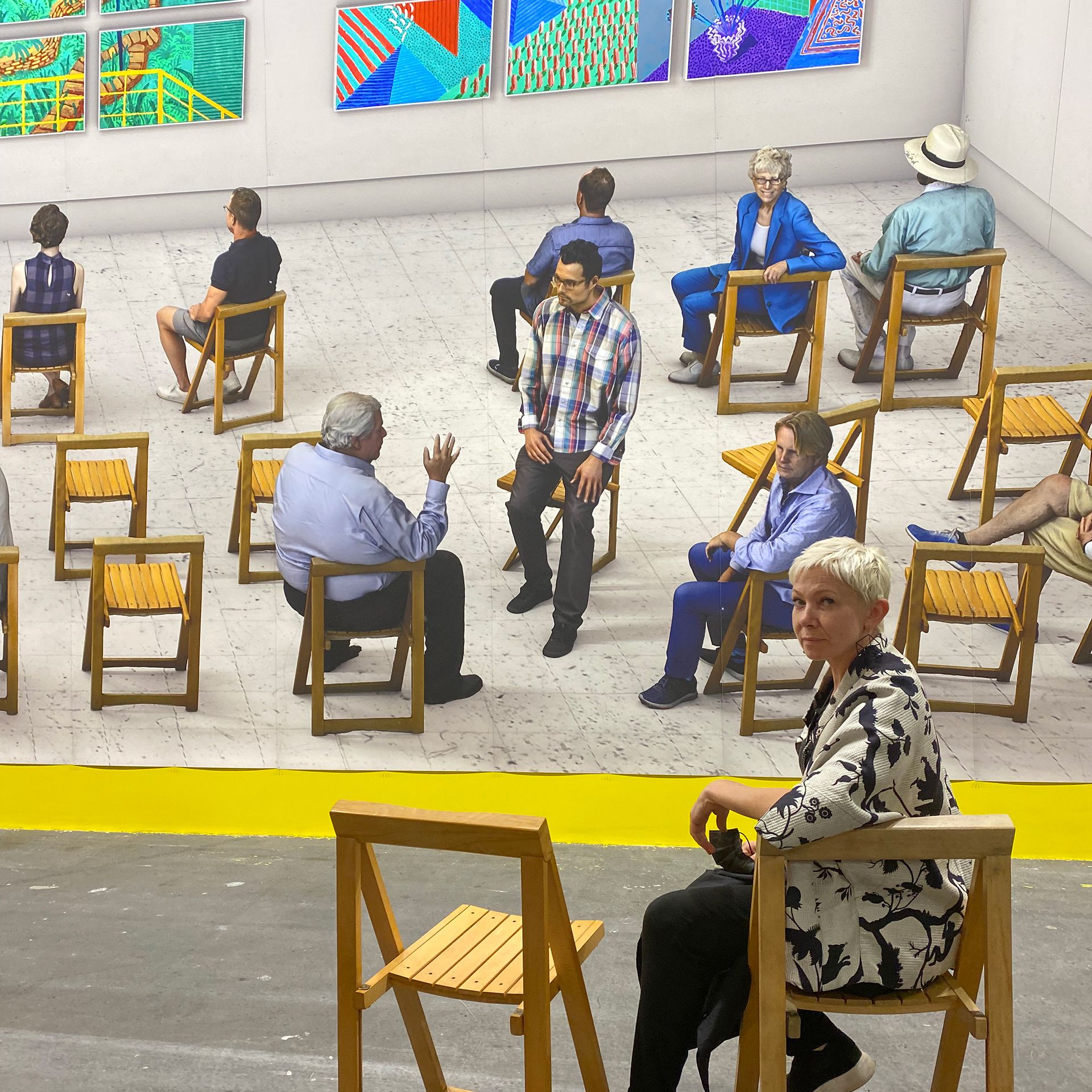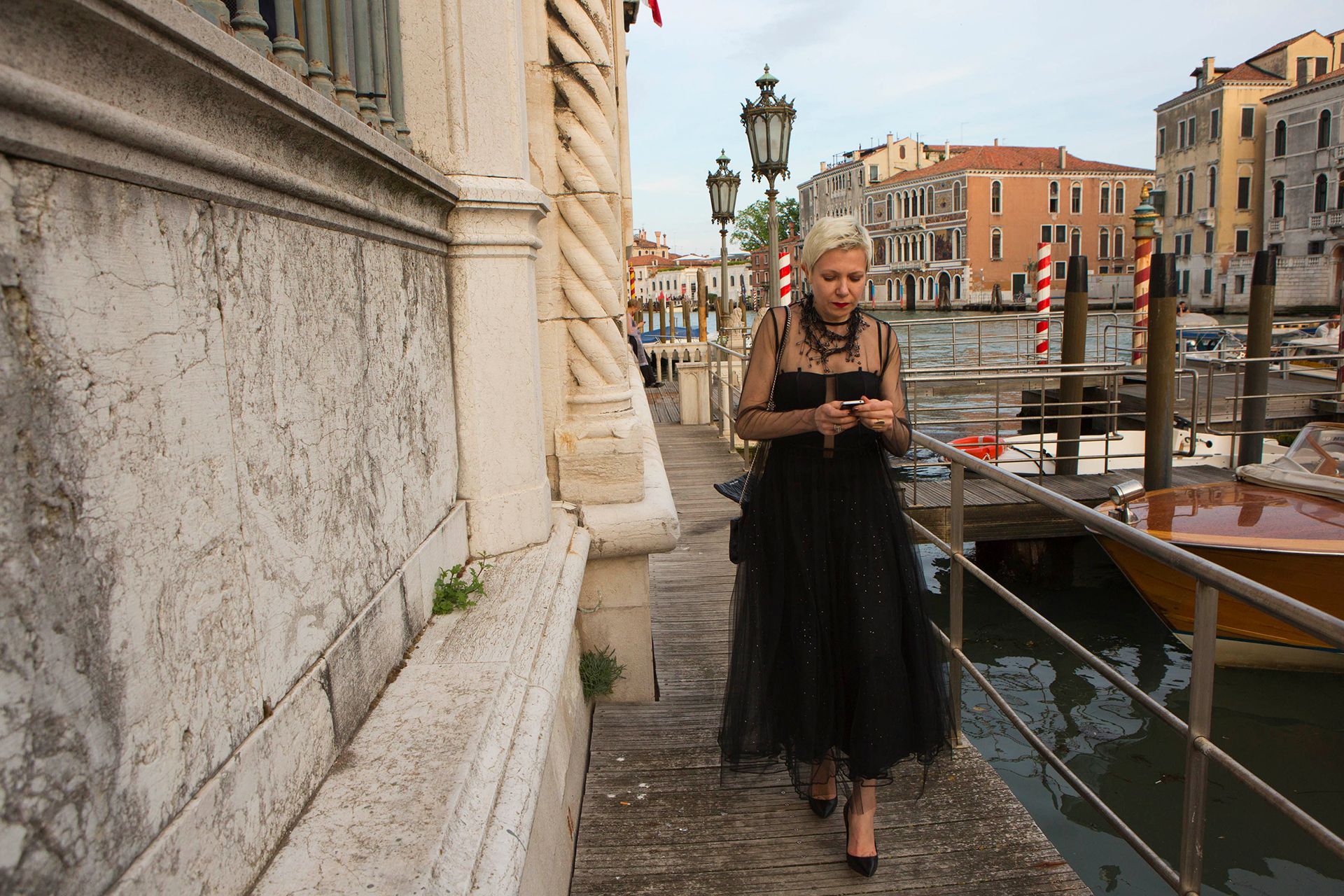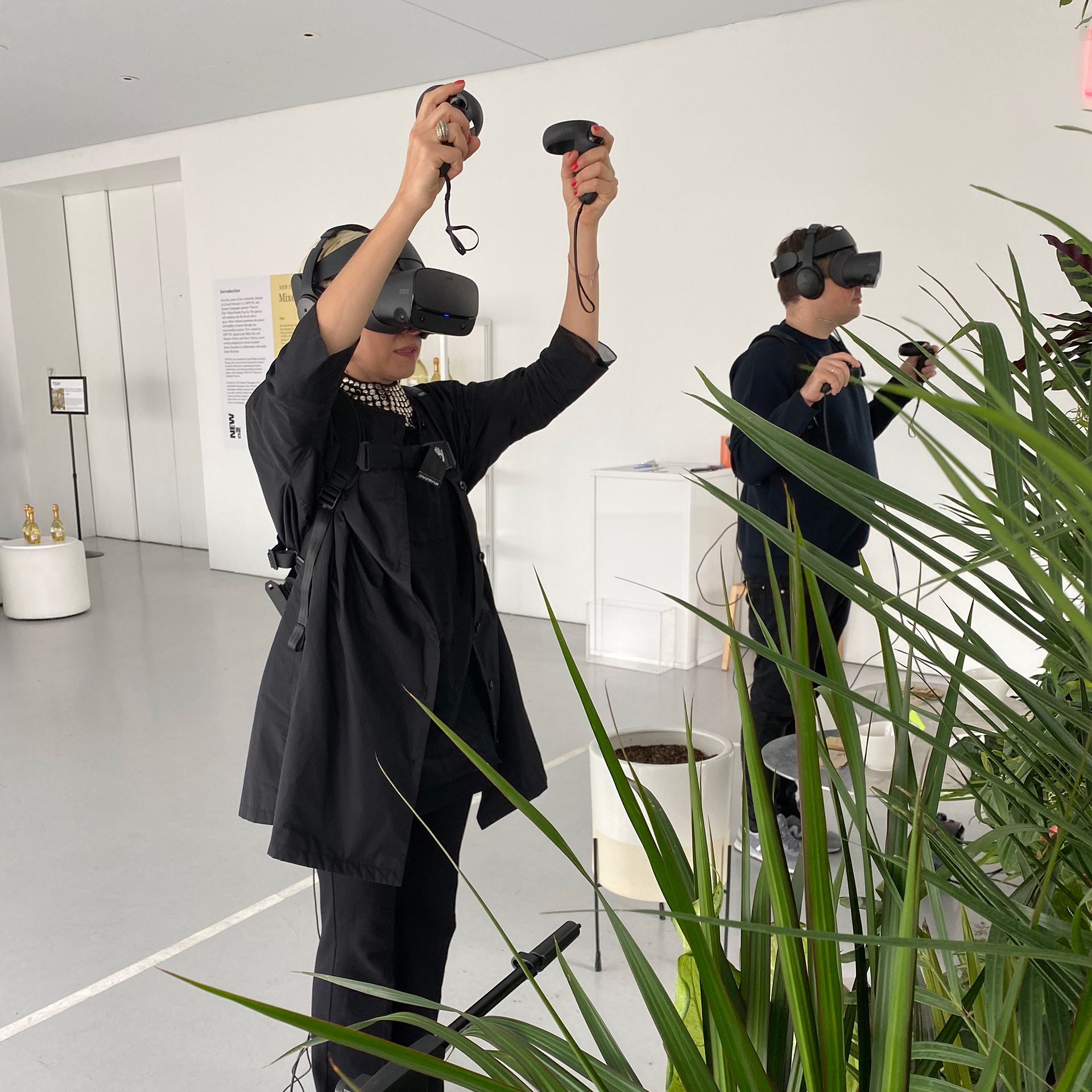From deep Siberia, through the US art scene, to the Metaverse

Nadia Taiga, the executive and curatorial director of OG.Art and Snark.art, talks about her journey from deep Siberia, through to the Venice Biennale and US art scene, to blockchain art and the Metaverse and about striving for eternity that drives both artists and collectors.
. . .
Your roots go back to a small provincial town in Siberia. What was your childhood like?
— I’ve always called Siberia the most mysterious place on the earth. For many people just imagining traveling there is like going to another planet. There is a mixture of the romantic and the frightening: shamans, bears, eternal winter and the GULAG, the brutality of life, and operating in survival mode. Despite all this, my “in the middle of nowhere” town Kolpashevo, with its powerful nature, was the best place in the world for me.
We lived on the edge of town, in one of the very last few houses, constricted from all sides by a deep, dark forest. One of the most prominent memories I have from my childhood is standing in front of an endless green expanse of land, spreading as far as the eye can see, with a never-ending blue sky settled above it, feeling capable of doing anything, feeling that anything is possible.
I suppose there were no art centers there. Despite that, you are currently working as an art producer and curator in the US. How did you develop your love for art in an environment where art was lacking
My aesthetic development was influenced by nature and my family. Everyone had their own creative hobby: my mom made amazing embroidered tapestries, grandma spun and knitted, dad was a writer. So my brother and I were encouraged to do what we liked. Although, many things were far from ideal.
My mom died when I was eight, and my stepmom, whom I call my second mom, came into my life a year later. She was a Germanic languages professor at Novosibirsk state university and she introduced me to the world of art in a way that got me hooked.

What was this introduction like?
— My stepmom was a traveler and art lover, and she gave me the most significant gift a girl behind an “Iron curtain” could receive – postcards illustrated with works of expressionists. I was blown away by Matisse, Renoir, Monet, Manet, and others. I used to keep those postcards under my pillow at night, and I would pick one up and get lost in the picture. I still have them at home here in Chicago.
She educated me on different painting techniques and how they manifested on the canvasand she also used to collect art pieces from local artists. We started traveling together at some point, and I followed in her footsteps by supporting local artists everywhere we went. We ended up owning more than a hundred socialist realism paintings, most of them I brought with me when I moved to the US.
One day, when I was already working in the US art market, I was wandering around the Art Institute of Chicago, which boasts one of the world’s largest impressionist collections. I found myself in front of Picasso’s “Guitarist”, the same picture I was staring at 30 years ago when I was 9. I had a moment of catharsis realizing how all the puzzles of my life came together piece by piece.
When did you move to the US, and what made you move?
I like this quote from the movie “Elizabeth. The Golden Age” where she asks: “Do we open the new world or does the new world open us?” It perfectly suits my approach to life: moving from country to country and to the Metaverse, or starting new business adventures to discover new facets of myself.
Somewhere between 2005-2007 I started to feel more and more uncomfortable running a publishing business in Russia. I think many entrepreneurs that remember the rotten Soviet Union system, made it through the crazy dangerous 90s and then started to be slowly cooked by Putin’s system, feeling that the ghosts of the totalitarian regime were coming back. I was not planning to immigrate, but suddenly fell in love with a friend of mine who lived in the US, crossed an ocean, and ended up in Chicago without my main tool — the language — but with a big dream to realize myself in the art field.
Italians say: when water comes into your mouth, you learn fast how to swim. So I figured out pretty quickly how the art market works, absorbing knowledge, and devotedly studying both English and art. It was not easy but a precious and exciting experience.
For many years you worked at the Venice Biennale. How did this happen?
— Neil deGrasse Tyson once said, "There are people who propel the evolution forward – people with the genes of explorers." Most immigrants possess these genes because when one begins their journey in a new field, they must invent new rules and bend the existing ones, often disregarding public opinion. I've always been told to stay in my lane, but I did everything my way, nothing could hold my dreams and aspirations back.
I'd go straight to the people who organized the art fares; I asked them direct questions regarding my willingness to participate, exhibit, and rent booths. It didn't matter if they took me seriously; almost none of them likely did; that was not the point – I gathered the necessary information and could weigh my options.

Once at the Art Chicago fair 15 minutes before the last day's closing, I met an Italian entrepreneur — Mr. Adriano Berengo, an art dealer, and producer who introduced glass as an art medium to contemporary artists, following in the footsteps of Peggy Guggenheim, who involved Picasso, Kokoschka, Le Corbusier, Lucio Fontana, and many others, in exploring glass as an art medium in late 50's – early '60s. He mentioned that he was looking for sponsors for his imminent Glasstress exhibition, a collateral event of the Venice Biennale.
By that time, I had invested almost all the money I had brought with me from Russia in my education and new life in the States. It was the recession of 2009-2010 and I wasn't making any. I began internally debating whether I should approach the Russian community and work in my native language field — or should I instead go with the flow and risk it all. To make the story short, I took a chance, invested the last of my money on a ticket to Russia, and did find two sponsors for the show and a few brilliant contemporary artists to create artworks for the Glasstress.
We succeeded with this initial exhibition, and I gradually began managing the whole show. For seven years, I traveled back and forth between Chicago and Venice, producing the whole process, starting from the artists' and partners’ involvement, to art-production, show set-up and sale.
My latest project in Venice was the Gotika show, organized by Berengo Foundation and the State Hermitage museum in collaboration with 56 artists from 20 different countries. We brought forth 56 art pieces from the Hermitage collection that hadn't been exhibited for more than two centuries. After that show, I decided to come back to the States to proceed with my own projects..
When the war in Ukraine started you organized a fare to support Ukraine. What's your take on this whole situation?
— The situation is devastating. When I left Russia in 2009, I got interviewed by the podcast team of "Svoboda" radio. They asked me why I was leaving, and I answered that with Putin in power, the country has been developing into an oil and gas trading corporation. Corporations like that don't need intellectuals and art; they require people working the pipelines. Add to that the imperial ambitions of the country's leadership, censorship, corruption, and poverty of a major population that is brainwashed, you've got a frightening picture of barbarism for the world to see.
Totalitarian regimes are able to eliminate individuals and many works of art, but never the culture. When the war started, we organized a fair called "Artists for peace", where we gathered all manner of artists to support Ukraine; we felt that we had to do something. We couldn't stop the war, so the feelings of powerlessness and devastation are still there, but the bravery of Ukrainian people and support to Ukraine from the whole world is inspiring.
Working with artists is a very delicate matter. It involves a certain degree of psychology. What's your opinion of this role of curator?
— My primary education is in psychology, and that definitely helps me to understand people and situations. I believe all people are the same, regardless of their social or monetary status. Everyone wants to love and to be loved. Everyone needs support. Artists are both vulnerable and strong. One needs guts to show their vulnerability after all.
The intellectual side of the job is very exciting. I'm incredibly lucky that I get to work with and learn from different artists every day. Artists are great storytellers! It's so interesting to delve into their narrative and figure out how it reflects the current state of the world, society, art, etc.

It's a matter of finding a proper approach to light their fire, you know? It's about finding out what their interests are and guiding them towards a medium with which their vision could best unfold.
Many people are skeptical of crypto and scared of its technicality and overall difficulty. What persuaded you to get into the NFT art world?
I can answer with the same quote by Neil deGrasse Tyson: "There are people who propel the evolution forward – people with the genes of explorers." At Snark.art and OG.Art we are a group of people with the explorer gene that aims to create art projects that will remain in art history.
It was early 2019 when I joined the team. Snark.art had already completed a few successful projects with Eve Sussman and the others. I understood what a fantastic tool blockchain was in broadening the horizons of art, and I went all-in again, regardless of the overwhelming skepticism around blockchain and crypto at the time.
Today, making blockchain-based art or NFTs has become trendy and is not complicated to do. What's exciting about Snark.art and OG.Art, in particular, is that it offers an experimental mode, a way to expand the conceptual ideas of art. I always tell artists that it's essential to filter out all the noise. Remove the outer shell of the medium and focus on its essence and mechanics. Blockchain allows for the ideas of transformation, communication, interactivity, personalisation, and micro/macro identity. There is so much an artist can learn from it!

The dynamic and generative nature of blockchain technology is going to help write a new chapter in the history of art.
NFT art has attracted a new breed of collectors. They seem to be completely different from conventional art collectors. Does it feel different working with them?
— It doesn't matter whether one is a conventional or a crypto collector; the essence of a collector is the same. An artist and a collector are two sides of the same coin. Artists create because they are driven by an inner call to leave their mark for eternity, to become eternal themselves in a way. It's not about living their best life most of the time. They are almost suicidal in this pursuit if we consider their success chances. Collectors move from the opposite direction – they’ve made their wealth and became successful in whatever walk of life they chose for themselves. But they realize at some point that money can't immortalize them and it doesn't satisfy them or grow them as a person. So, they begin collecting subconsciously, having an idea to be immortalized as benefactors and rightful owners.
We all deal with an existence between birth and death and searching for the higher meaning of life. Both art creation and collecting come from the struggle to fulfill that short journey we call life, and they meet at the most crucial point of the search.
Most collectors beginning their journey ask me whether their collections can become profitable, to which I always say that they need to buy art they actually like, regardless of the author's prominence. Should the author succeed, they'll kill two birds with one stone, and should they not – they're still left with a piece they like that has a story behind it.
So, you're saying crypto art collectors aren't any different from the conventional ones?
— They aren't, even though they began their journey through speculation and a wish to buy and sell. In the end, many collectors refuse to part with pieces they bought, having spent some time with them.
Humanity is horrible. We create wars, poverty, and famine and destroy the planet and its nature. But, I firmly believe that through art, we reflect the good in human nature. This good urges people to search for a deeper meaning to their existence, to capture the essence of things. Many collectors may start with buying some decorative pieces or PFP pictures, but then they dig deeper, and learn how things work, what certain art and artist stands for, and how the narrative is being built. They become invaluable supporters of the artists themselves.
So I feel very comfortable collaborating with these new crypto collectors and artists and feel comfortable in the crypto world.
It reminds me of my natural childhood environment. Metaverse is in many ways like Siberia. It's a strange place with no borders, limits, and unique conditions of being. It's away from all the familiar beaten paths. You can not accidentally find yourself there. You need to strive hard to get there. But if you do, it gives you unlimited possibilities.
For this reason, our team has taken this quote from Lewis Carroll's "The Hunting of the Snark" as our motto: "The Impossible Voyage of an Improbable Crew to Find an Inconceivable Creature"!

